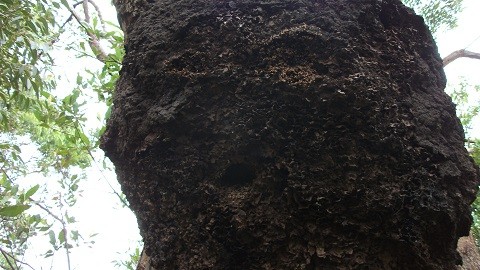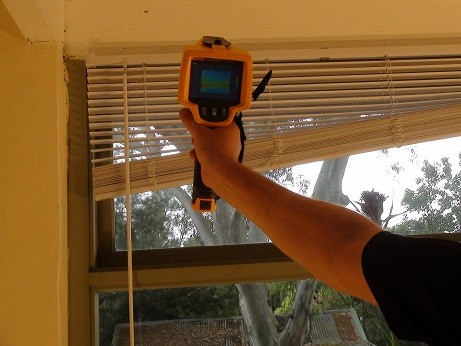Pest Inspections by Professionals
Mobile Users Only Click Here To Call 0417 251 911
It pays to get the most accurate pest report that is available, as the small investment may stop you from making a very costly mistake! All of our technicians have licences, and are fully insured.
How are we different?
What separates us from the other pest inspectors are our experience and our termite inspections. See Termatrac and our latest Fluke Thermal Termite Inspection camera. A few firms have Thermal Imaging but not many also have Termatrac – which can track termite’s movements, heat and moisture through building materials. Most other firms just use a moisture meter and tap timbers. We take all the guesswork out of Pre-purchase Pest Inspections.
A timber pest inspection will consist of either:
1. A licenced pest inspector conducting a visual inspection of accessible areas or;
2. A Thermal Imaging Inspection of a residential or commercial property to inspect for active subterranean termites or termite damage to structural timbers.
The pest report will note all of the conducive environmental conditions to termites, also noting the risks and any recommendations for treatments that may be necessary.

What is a Pest Inspection?
A pest inspection is normally a visual inspection or in same case a Thermal Report of the accessible areas of all buildings and outbuildings of a home or business. We would check for evidence of all timber pests and decay. Our inspectors will always visually inspect your interior areas of your home (that includes accessing and also entering all of the roof or sub-floor locations) and the exterior, gardens and outbiuldings of the property. After the inspection has been performed, all recommendations and the findings are then reported on the termite report form.
How long does an inspection take?
The average pest inspection for termites will take up to 60 minutes to 2 hours for a complete and thorough inspection. Of course this will depend on the size of the home and property grounds.

How Do I Recognise Termites in My Home?
Termites have subterranean (underground) colonies which have 3 very different castes or types of termite which reproduce, do the work, and protect the colony. They are called respectively; Reproductives, Workers and the Soldier caste members.

They are commonly referred to as “White-ants” as they white and about the shape & color as rice grains. They are not strictly an ant and are not pinched in the middle as an ant. The reproductives or “Alates” (swarmers), have even-sized wings & are mistaken quite regularly for flying ants. The workers are smaller, are blind, and don’t have wings.
The soldier caste are how pest technicians who are well-trained in termite inspections may identify the termite species. They are able to do this by noting the shape of their heads. They have fearsome mandibles, and some species may shoot a white sticky substance from their pronotums or heads in order to protect the colony from attack.

What is the difference between ants and termites?
There are a number of differences between ants and termites. The body shape of an ant is like an hourglass- it narrows between the abdomen in the rear and the thorax in the front. The bodies of termites are more cigar-shaped than ants without having the narrow section between the abdomen and head of the body. Ants have larger wings than the white ants that have wings. You will also find that ant wings are considerably less “veiny” than those of termites.
Another difference is that ant antennae are jointed (somewhat bent or curved), while the termite antennaes are straighter than ants. Termites will eat the timbers that they tunnel through, ants will just carry away the rubbish, including their dead that get in the way of their tunneling.
What is the best way to treat termites?
An insecticidal treatment is known to be the most effective way of treating subterranean termites. This is when there is enough friable soil (campered do rocky or non-existant soil). This is commonly known as a “termite barrier”.
A low toxic, environmentally safe chemical treatment may be installed to perimeters of buildings. Accord to the Australian Standard AS 3660, termiticide is applied in the soil 50mm below the top of the footings. This is to help stop termites from entering and destroying timbers within buildings. Accredited technicians will either drill or cut through concrete to get to soil, or lift pavers and trench soil underneath. Either repellant or non-repellant termiticide (our preferred termiticide is Termidor) is then pressure injected or otherwise drenched into the soil. This will create a protective area around the property.
Termite Baiting
Baiting is also a popular system for the treatment of termites. A termite baiting system will involve the placement of plastic bait stations containing timbers at 3 metre intervals around the perimeter of the building. Worker and soldier termites will bump into these bait stations and let off scent trails to take other white ants to the timbers.
After it is found that activity has commenced in the stations, the timber or other cellulose material is replaced with the actual “bait” – a chemical inhibitor, which will retard the moulting process in termites. This will prevent them from shedding their cuticle (their version of our skin) from growing. The affected termites will then take the bait back to the nest and spread the chemical inhibitor throughout the rest of the colony. This will lead to the destruction of the rest of the colony .
Termite workings are found. Is there a chance that there may be more damage elsewhere?
Yes, absolutely! There may be even more damage in inaccessible areas. Termites and also termite colonies may often avoid being seen in the open air and they will attempt to avoid lights. This means that they will be determined to stay underground or be hidden within timber products. It is very difficult or even impossible to detect, identify, or even locate active termite infestations by looking or tapping the surface of wall and ceilings. That’s why we use Thermal Imaging cameras and Termatrac for areas with difficult to access areas.
What can I do to Prevent Termite Infestation?
Simple procedures can really help to “build out termites” and aid to their prevention. Some conducive conditions for termites include: Timber in ground contact at the base of posts; loose timbers and formwork left behind in the subfloor; pooled water from poor drainage adjacent to buildings; & inadequate subfloor ventilation. Just implementing the correction of these conducive conditions may reduce the risk of an infestation from high to moderate. In our opinion, the best method of preventing termite infestations is to have regular six monthly inspections, install monitored baiting systems and install Termidor termiticide to all at risk areas, especially to the subfloor.
Why do I have to treat if there are no live Termites?
If we find that there is some evidence of termite infestation and there is no visual evidence or documented of a termite treatment in place, we will let you know what needs to be done to protect your property from termites. it is part of our duty of care to you that we recommend that the buildng is in need of termite treatment. This recommendation will be made even if no live activity was discovered, as an infestation is more likely to attack again.
Call Bruce on 0417 251 911 if you have a pest inspection due or email him at:

